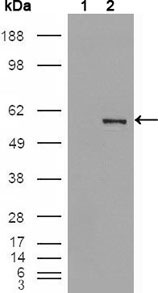ETV4 Antibody
Purified Mouse Monoclonal Antibody
- 产品详情
- 实验流程
Application
| WB, E |
|---|---|
| Primary Accession | P43268 |
| Reactivity | Human |
| Host | Mouse |
| Clonality | Monoclonal |
| Clone Names | 1A2G3 |
| Isotype | IgG1 |
| Calculated MW | 53938 Da |
| Description | ETV4: ets variant gene 4 (E1A enhancer binding protein, E1AF), also known as PEA3. Several members of the Ets gene family are known to encode sequencespecific DNA binding proteins. These include mouse PU.1, mouse and human Ets-1, Drosophila E74, chicken and human Ets-2 and rat GABP-α. Each of these proteins recognizes similar motifs in DNA that share a centrally located 5'-GGAA-3' element. For instance, PEA3 binds the motif 5'-AGGAAG-3' (the PEA-3 motif), but does not bind to the sequence 5'-AGGAAC-3', recognized by PU.1, although PU.1 binds equally well to both sequences. It appears that all of the Ets proteins recognize the same central core sequence but that each protein interacts with unique sequences that flank this core. PEA3 is expressed at readily detectable levels in cells of epithelial and fibroblastic origin but is not expressed in hematopoietic cells. This is in contrast to other members of the Ets gene family, such as Ets-1, Ets-2 and Fli-1, each of which is expressed primarily in cells of hematopoietic origin. |
| Immunogen | Purified recombinant fragment of human ETV4 (aa50-109) expressed in E. Coli. |
| Formulation | Ascitic fluid containing 0.03% sodium azide. |
| Gene ID | 2118 |
|---|---|
| Other Names | ETS translocation variant 4, Adenovirus E1A enhancer-binding protein, E1A-F, Polyomavirus enhancer activator 3 homolog, Protein PEA3, ETV4, E1AF, PEA3 |
| Dilution | WB~~1/500 - 1/2000 E~~N/A |
| Storage | Maintain refrigerated at 2-8°C for up to 6 months. For long term storage store at -20°C in small aliquots to prevent freeze-thaw cycles. |
| Precautions | ETV4 Antibody is for research use only and not for use in diagnostic or therapeutic procedures. |
| Name | ETV4 |
|---|---|
| Synonyms | E1AF, PEA3 |
| Function | Transcriptional activator (PubMed:19307308, PubMed:31552090). May play a role in keratinocyte differentiation (PubMed:31552090). |
| Cellular Location | Nucleus {ECO:0000255|PROSITE-ProRule:PRU00237}. |
| Tissue Location | Expressed in keratinocytes. |
Research Areas
For Research Use Only. Not For Use In Diagnostic Procedures.
Application Protocols
Provided below are standard protocols that you may find useful for product applications.
REFERENCES
1. J Biol Chem. 2005 Apr 1;280(13):12503-16. 2. Mol Carcinog. 2006 Sep;45(9):667-75. 3. Oncol Rep. 2006 Jul;16(1):153-8.
终于等到您。ABCEPTA(百远生物)抗体产品。
点击下方“我要评价 ”按钮提交您的反馈信息,您的反馈和评价是我们最宝贵的财富之一,
我们将在1-3个工作日内处理您的反馈信息。
如有疑问,联系:0512-88856768 tech-china@abcepta.com.























 癌症的基本特征包括细胞增殖、血管生成、迁移、凋亡逃避机制和细胞永生等。找到癌症发生过程中这些通路的关键标记物和对应的抗体用于检测至关重要。
癌症的基本特征包括细胞增殖、血管生成、迁移、凋亡逃避机制和细胞永生等。找到癌症发生过程中这些通路的关键标记物和对应的抗体用于检测至关重要。 为您推荐一个泛素化位点预测神器——泛素化分析工具,可以为您的蛋白的泛素化位点作出预测和评分。
为您推荐一个泛素化位点预测神器——泛素化分析工具,可以为您的蛋白的泛素化位点作出预测和评分。 细胞自噬受体图形绘图工具为你的蛋白的细胞受体结合位点作出预测和评分,识别结合到自噬通路中的蛋白是非常重要的,便于让我们理解自噬在正常生理、病理过程中的作用,如发育、细胞分化、神经退化性疾病、压力条件下、感染和癌症。
细胞自噬受体图形绘图工具为你的蛋白的细胞受体结合位点作出预测和评分,识别结合到自噬通路中的蛋白是非常重要的,便于让我们理解自噬在正常生理、病理过程中的作用,如发育、细胞分化、神经退化性疾病、压力条件下、感染和癌症。







